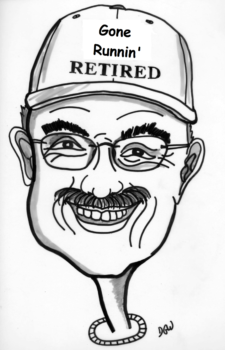In my conversations with John Robbins in the 1990s, he conveyed his ideas to promote running in the Fredericksburg Area. Though these recollections are second-hand, I’ll take John’s word.
In 1993, John spent many hours at the Rappahannock YMCA. Between workouts and runs, he spent timing irritating Terry McLaughlin and Barney Reiley. Terry was the Special Events Coordinator, and Barney, the former Special Events Coordinator, had just become the CEO.
John had two ideas: creating a local running club to find people to run with and holding a race on Thanksgiving. Both Barney and Terry did not think a race on Thanksgiving morning would work but acquiesced and planned a race for 1993.
The Buffalo YMCA manages the oldest continuous race in the United States. The Buffalo Turkey Trot is a five-mile race, first held on November 26, 1896. The Buffalo race has been held for 127 years through wars, pandemics, and epidemics. However, the 2020 race had a limited field of only 125 runners.
I don’t know if Turkey Trot is trademarked or if Barney and Terry knew of the YMCA’s name use. Their initial race, called the Turkey Trot, was held on November 25, 1993,
One of the races Barney founded and managed was the River Run, held in March or April. The race had existed for about ten years, and over time, the venue moved to the Library on Caroline Street with a course entirely north of William Street.
Using the same course as the River Run and a 9:05 am start, the first Turkey Trot had about 150 finishers, with Terry as the race director. Chris Campbell was the first finisher.
The race used an uncertified course for the first two years. In 1995, we certified the River Run and Turkey Trot course. This route was the first map I measured for USATF certification.
Participation increased to over 300 in 1994, over 600 in 1997, and over 800 in 1999. By 2001, the race drew more than 1000 finishers.
In 2003, Terry invited a group of Kenyan runners from Chapel Hill, North Carolina. The YMCA paid travel expenses for the group. Through 2021, Kenyan runners challenged local runners, posting winning times in 14 minutes for males and 16 minutes for females.
After 1199 finishers in 2003, Terry realized the manual timing procedures FARC provided were no longer optimum and contracted with Kale Running of Virginia Beach to provide chip timing using Championchips.
With a requirement for a larger finish zone, we measured the course to move the start line closer to Amelia Street and the finish closer to Lewis Street,
Because of the extra cost of chip timing, the YMCA dropped the race from the Coldwell Banker Elite Grand Prix. Except for 1996, the race had been part of the series from 1994 through 2003.
For the 2004 race, the YMCA handed out chips at packet pickup in the days before the race. Runners tied the Championchip into their shoelaces. With the inexperience of the typical race participant, over 100 chips never made it to the race or returned after finishing, costing the YMCA over $3000 in lost chip fees. After that year, the YMCA distributed chips on race morning near the start line.
The 2007 race returned to the Grand Prix with 1600 finishers. The race stayed in the series until 2010. The 2009 race had 2417 finishers and outgrew the downtown venue. With the new James Monroe High School building, Terry moved the race venue to the school for 2010 with a new course.
Race participation continued to grow. After 2701 finishers in 2011, the city asked the YMCA to move the race from the streets below the college to Central Park.
This course was super fast, with a first-place time of 14:07 in 2013. However, with the move to the expo center, only 2198 runners finished that year.
There was a protest from runners with the move to Central Park, and an unauthorized “Turkey Knot” was held on the downtown course in 2012, attracting over 100 runners and a front-page article in the Free Lance-Star.
In 2013, the organizers of the Turkey Knot were given a permit by the city for their event, impacting participation in the Central Park event.
Working with the city, the YMCA developed a downtown course to handle the volume. With Race Timing Unlimited’s new Chronotrack disposable timing tag system, a start line separate from the finish line used a wave start procedure. With five start waves, the impact on residents was reduced on a course starting at James Monroe High School.
In the first four years of the new course, fields of nearly 3000 finishers were typical, with a peak of 3149 in 2015.
Looking at runwashington.com and racepacket.com in 2018, there were over 40 races listed on Thanksgiving morning in the Washington, DC area. The many race options trimmed the fields that finished the twenty-teens to 2300, and then 2020 happened.
With Terry’s retirement and Arsenal Events’ purchase of Race Timing Unlimited, new faces were working on the race. After COVID shut down races from March to June, the YMCA and Arsenal developed a safe procedure to provide a social distancing race. However, with a spike in infections in the weeks leading to Thanksgiving, the YMCA held a virtual event. In 2020, only 237 runners reported finish times.
In 2021, a COVID vaccine helped runners become comfortable with races, and 1911 runners finished. The city required a start time that would clear the streets by 9 am. Even with the 7:30 am start time, participation was up to 2382 in 2022.
The 31st edition will be held on November 23, 2023, with the bright-tailed start of 7:30 am. What is the attraction of a 5 km on Thanksgiving morning? By burning those 300 calories, you can eat anything you want for the rest of the day.
Did you notice the improvement in my map drawing?
